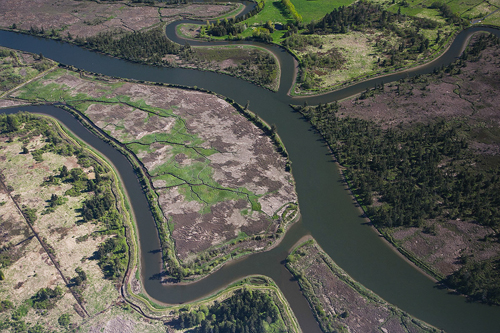For Healthy Rivers, Farms, Communities in the Face of Climate Change
Written by Cathy Baker, Federal Director of Government Relations, April 21, 2015
Photograph by John Marshall
On the eve of Earth day, the White House recognized Puget Sound as a model for climate change adaptation, making it one of four places in the U.S. where increased cooperation will aid in preparation for the impacts of climate change –including sea level rise, drought, flooding and wildfires.
The Puget Sound region was showcased in the Resilient Lands and Waters Initiative for outstanding efforts in local, state, federal and tribal partnerships around Puget Sound recovery. The release highlights recent successes and builds momentum for efforts to restore floodplains, preserve farmland and reduce flood risk through the innovative Floodplains by Design program and Snohomish County’s Sustainable Land Strategy.
Read the Seattle Times story for more coverage.
“We are living with the evidence of a changing climate,” said Mike Stevens, Washington State director for The Nature Conservancy. “Longer and more intense winter flooding, low river flows in the summer, and rising seas are affecting both cities and farmlands in the Puget Sound region. “
In Snohomish County, local leaders have developed the Snohomish Sustainable Lands Strategy which brings together Tulalip and Stillaguamish Tribes, government agencies, and local agriculture, and other interests to tackle these issues together.
“Thanks to Sustainable Lands Strategy partners, leadership by Snohomish County Surface Water Management, and the support of the Floodplains by Design program, the county has an assessment of risk and a plan to make the river valleys more resilient in the face of those risks, to the benefit of both people and nature,” Stevens said.
“We are trying to prepare for the future under changing climate conditions,” said Terry Williams of the Tulalip Tribes, a key partner in collaborative efforts underway in Snohomish County. “In the Snohomish River Delta we are getting 500-year-floods more frequently, early spring flooding, early drought. Eighty percent of the delta was diked 100 years ago, and we lost a lot of fish habitat. Mix that with land use that includes forestry, agriculture and urban development—all of that affects the landscape.”
“We’re figuring out how to address these landscapes, these changing conditions, and capitalize on them so we become stronger, rather than weaker,” he said.
“This designation speaks volumes about what we’ve accomplished,” said Tristan Klesick, of Klesick Family Farms. “It’s not easy work, but it’s valuable and important. We have to be stewards of the environment and the economy – we have to have a place for salmon and salamanders, corn, broccoli and milk, homes, schools and hospitals.“
“We look forward to engaging in this opportunity to build upon our efforts to bring government and our communities together to address the natural resource challenges we face,” said Snohomish County Council Chair Dave Somers.
The Nature Conservancy has contributed both science and leadership to this work.

